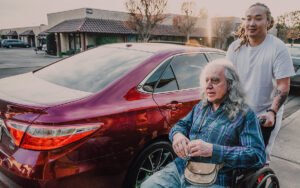
Editor’s Note: Despite sweeping federal and state laws addressing education and other services for children and adults with disabilities, the experience of each affected person and family with “the system” is unique. Passionate, involved parents become case managers, experts, and advocates for their children while dealing with a never-ending array of professionals and service providers who have their own ideas—and budgets—to serve a person and family with special needs.
In this article, Jill Barker talks about her adult son, Danny, and addresses the problems with assuming that the philosophy and practice of inclusion (often incorrectly referred to as “mainstreaming”) is appropriate for all situations and all people. Her story illustrates the paradox of “people-centered” services when the services design is built with one idea of what all people need and value.
My son Danny is forty years old this week. He has multiple disabilities resulting from brain damage acquired during his first few days after birth. He functions at the level of a 6 to 12 month old infant and always will. And, yes, I know he is not really an infant. We do not love him less because he lives and survives with profound developmental disabilities.
I’ll spare you the details of his birth and the aftermath. It’s enough to say that while the other mothers whose babies were being discharged from the hospital were learning how to give their babies a bath, I was receiving instructions on how to administer CPR to an infant.
I first heard the term “inclusion” around 1990. Danny was 13 years old and attending High Point School in Ann Arbor. High Point was an outstanding program for Danny, bringing together services, expertise, and a supportive community to accommodate children with the most severe disabilities, including complex medical and behavioral conditions.
Inclusion, when applied to schooling for disabled children, is the belief that all children, regardless of the severity or nature of their disabilities, can and should be educated in regular classrooms with their non-disabled peers. Inclusion was promoted by many disability advocates as a right for every child. Most discussions of the idea did not include an examination of whether the premise on which the belief is based is true for every child, or whether the (federal) Individuals with Disabilities Education Act requires it. (It does not.) In the face of any disagreement with the idea, promoters of inclusion encouraged families to take sides: “Are you for ‘inclusion’ or against it?” Or as many advocates would have it, “Do you want disabled children isolated and segregated from the rest of society or do you want them to be fully integrated into and embraced by ‘the community’”? This continues to this day.
“The Inclusion Delusion” began with a false and unprovable assertion based on wishful thinking and a willful misinterpretation of federal law. In 1990, there were many disabled children who were unjustly and illegally prevented from participating in classrooms with their non-disabled peers and there still are. Many of their parents understandably leapt at the idea that by proclaiming a faith in Inclusion, their children’s needs might finally be recognized and fulfilled.
But the uncritical acceptance of the Inclusion Delusion disregarded a number of moral and ethical questions: Is it right to make judgments about “all children with disabilities” without considering their individuality and acknowledging the full range of their diverse needs? Do advocacy organizations or government agencies have a right to impose on children and their parents an all-encompassing doctrine when the parents and others who know the child best have good reason to disagree? Is inclusion the ultimate goal of educating children with disabilities or are the needs of the individual child paramount in determining educational services and placement? Is Inclusion a cause that must be served, whether or not it is appropriate for a specific child?
In the early 1990s, the indoctrination for inclusion in schools was intense, an obvious sign that the project was well funded and a great opportunity for organizations and local agencies to tap into a new funding stream. I attended a meeting sponsored by our local ARC (formerly the Association for Retarded Citizens) featuring a speaker from another state. She gave a rousing speech citing success stories of even the most profoundly disabled children blossoming in the presence of their non-disabled peers. Non-disabled children, she said, were learning acceptance, tolerance, and the value of people with disabilities to society and their fellow citizens.
As I listened, I pondered how Danny would be accommodated in a regular middle school classroom? How would they deal with his bouts of vomiting after meals, the necessity for frequent diaper changes, and his need for floor space for his favorite activity—rolling over? Would other students and staff tolerate his occasional bloodcurdling screams when things weren’t going well for him? Was it wise to remove him from an environment that had every accommodation that he needed and place him where virtually nothing was geared toward his needs? Could anything prevent him from becoming the chief source of disruption for almost every activity that normally occurs in a typical classroom?
I started to pay more attention to the speaker when she offered up some good advice: “Give people with disabilities what they need and want! If you want to know what they need and want, ask them!”
Sign up for our free newsletters
Subscribe to NPQ's newsletters to have our top stories delivered directly to your inbox.
By signing up, you agree to our privacy policy and terms of use, and to receive messages from NPQ and our partners.
Now, that made sense to me and I became more optimistic that I would get something out of the evening beyond a welcome break from caregiving. My optimism was soon crushed, however. The speaker followed her initial advice with a list, her list, of all the things people with disabilities are supposed to need and want. She did not ask if the audience agreed with her.
“They all want to be treated like everybody else,” she said, apparently oblivious to the fact that Danny would die if he were “treated like everybody else.” She went on: “They want to live independently and make their own decisions; they want to go to regular schools and work at regular jobs; they want to be included in their communities in every aspect of life.” Some of the items on her list made sense to me, but most did not considering the complexity of Danny’s severe disabilities.
On another occasion, I saw a film of children’s responses to having disabled students in their classrooms. One boy said he had learned that, “Disabled people can do everything that everyone else can do. They just have to try harder.” I can understand a child coming to such a simplistic view of disability, but for the adults to include it in a film promoting Inclusion raises questions about their judgment. Poor Danny, I thought. With that kind of “learning,” what would ignorance look like?
Danny continued at High Point School for another 13 years. As the inclusion movement took hold, many children were moved out to local schools, some with the approval and support of their parents and some without. There were threats that the school would close and it almost did. Finally, a charter school and other programs sponsored by the County school district moved in to the empty classrooms and eventually filled the space left by special ed students who had moved out. The integration of High Point and the charter school proceeded at a relaxed pace and was not forced where it was not appropriate for the students involved. At the same time the integrity and the usefulness of the High Point program continued to function to the benefit of the most severely disabled children in Washtenaw County.
Was this an example of the success of inclusive education? I don’t believe so and it certainly did not meet the criteria set by advocacy organizations that demanded that disabled children be seen to hobnob with their non-disabled peers to prove to the world they were just like everybody else. The purpose of High Point was never to isolate and segregate its students from the broader community, but to give them an environment and specialized care that was not likely to be achieved anywhere else.
The inclusion movement in education was an ideological undertaking, more enshrined in the imagination of zealots than in the laws and policies governing the education of actual children with disabilities. The 1975 Education for All Handicapped Children Act was in full swing by the late 1970s and early 1980s, with the majority of children in special education, those with learning disabilities and speech and language problems, attending their neighborhood schools and spending most of their time with children who were not disabled. It was true that schools still ignored the needs of children who caused them inconvenience or were difficult to accommodate or educate, but parents were getting the idea that with a lot of hard work and belief in themselves and what they knew about their children, it was possible to make headway with the new protections and rights afforded their children.
This Inclusion Delusion, that all children could be accommodated in regular classrooms, signaled a dramatic shift in thinking. Rather than determining the education that each child received based on his or her unique needs, it made the assumption that every child could succeed in placement in regular classrooms. If that did not work, the parents, the schools, and the professionals must have done something wrong. Or, as one parent said in another short documentary promoting inclusion, “Even if it doesn’t work, you should do it anyway. It’s the right thing to do.”
For years, the proponents of Inclusion in schools have pitted parents against parents, demonized teachers and staff who work with children in specialized classrooms and special schools and set the stage for years to come for disability movements based on over broad generalizations about people with disabilities.
In the mad dash to close institutions and many other specialized programs for people with disabilities, the people directly affected by these closures were rarely asked their opinion early enough in the process to make a difference. Instead, advocacy groups, especially those that receive federal funding to promote their causes, claimed to represent people with disabilities and swooped in with all the answers: No one would choose to live in an institution or group home, work at a sheltered workshop, attend a day program with other people with disabilities, or live anywhere but in their own home or at home with their family. All people with disabilities can and should live independently, make all their own decisions, and work in integrated, competitive work settings.
The truth is that there are people with disabilities who can do only some of these things, some who can do none of them, and some who choose to do things differently than other people with similar disabilities. They have been marginalized. The closure of programs and services that meet their needs has been justified with the promise that closing programs that no one wants, according to the advocates, will pay for more services to more people, “in the community.” This is unlikely to ever be realized as states see “savings” as opportunities to fund more popular government- supported programs (such as fixing potholes), to reduce taxes, and to continue to ignore many of the needs of people with disabilities. Attempts to develop innovative family-initiated projects to serve and house people with disabilities that may actually save money in the long run are also being thwarted by advocates who fear any incursions into the territory they have claimed for themselves as the representatives of all people with disabilities.
Thanks to Danny (and Ian, who came along eight years later), my blog has been an attempt to set the record straight, give a voice to people who are rarely heard, and attempt to restore some balance in the stories that are told about people with disabilities. This is an unbelievably frustrating time for families who see their judgment questioned at every turn as they attempt to salvage necessary services for their loved ones and hope for a truly inclusive future that acknowledges differences in abilities and needs and honors the choices that families and their loved ones must make.









